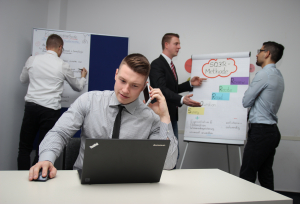Three Tips to Reducing Stress in Traffic
 #1: Change expectations. One reason people get stressed in traffic is that their expectation for the amount of traffic they’re expecting is often different than the reality of the volume of traffic. By approaching the driving time with an open mind and without expectations for the way things “should be,” people are less likely to get stressed.
#1: Change expectations. One reason people get stressed in traffic is that their expectation for the amount of traffic they’re expecting is often different than the reality of the volume of traffic. By approaching the driving time with an open mind and without expectations for the way things “should be,” people are less likely to get stressed.
#2: “Be” in the traffic. If you’re stuck in traffic, accept that this is where you are right now. And not only are you “in” the traffic, you’re part of the traffic! You’re in a community of people who are all stuck in this same situation, all wanting to get to where they’re going.
#3: Notice negative thinking. Negative thinking can amplify stress. If you notice negative thoughts about being in traffic, see if you can focus on something positive about the situation instead, like being grateful for having a car, or having a cell phone to let someone know you’re running late.
Managing your mindset can go a long way to reducing stress levels. Remember, you can’t change external events—you can only change your response to them.
Take time out to sharpen the axe!
 As the old saying goes, you have to take time out from chopping the tree to sharpen the axe. Since your mind is one of your main tools, it’s vital to keep it sharp. By pausing to take a mindfulness break throughout the day, you’re doing the axe-sharpening work.
As the old saying goes, you have to take time out from chopping the tree to sharpen the axe. Since your mind is one of your main tools, it’s vital to keep it sharp. By pausing to take a mindfulness break throughout the day, you’re doing the axe-sharpening work.
Here are three tips to help support a mindfulness break:
1-Breathe mindfully for a few minutes. Bring all your attention to your breath as it moves in and out of your body. You may want to notice the coolness of the air as you breathe in and its warmth as you breath out—or you may want to notice your chest rising and falling. Anytime your mind wanders, gently bring it back to your breath. Alternatively, count with each breath until you reach 40. (Or 50, or 60 …)
2-Listen mindfully for a few minutes. Sit in a comfortable position and gently lower your eyelids. Notice the sounds you hear. Try not to judge the sounds with thoughts of liking or not liking. Simply listen. As thoughts enter your mind, see if you can release them and bring your attention back to what you hear.
3-Hang a reminder in your office space. It can be challenging to remember to pause for your break. Hang a picture of something from nature or anything that reminds you to take a moment and pause. You could even schedule your breaks into your calendar.
By doing this axe-sharpening work, you’re clearing your mind and improving your focus for the tasks that lie ahead. Mindfulness breaks are available to you most anywhere and anytime. Taking a break just takes intention—and remembering!
Mindful Sales: 5 Ways to De-stress
 While sales can be a stressful profession, it doesn’t have to be. Here are five ways to de-stress in the new year:
While sales can be a stressful profession, it doesn’t have to be. Here are five ways to de-stress in the new year:
1. Get to the appointment early. Park your car and take time to focus on your breath to help quiet your mind, listen to a motivational recording, or engage in any other practice that will help center you before you meet with your prospect.
2. Get a clear picture of the time with the prospect: Imagine the sales call as you’d like it to go. Imagine asking your clients questions about their needs, and listening closely to their responses. Imaging being totally “present” in your time with your client, rather than lost in fears about the past, or anxieties about the future. Imagine explaining the features and benefits of your product as they relate to your clients’ needs. Imagine a partnership forming between you and your client, as you take a consultative role. Imagine the handshake at the end of your time together and a promise for business to come.
3. One calming practice is to use a smooth stone for “grounding.” Prior to the appointment, hold the stone, and imagine the qualities of strength and steadiness, like a mountain. If a sales rep finds anxieties arising on the sales call, simply reaching into a pocket and touching the stone can act as a tangible reminder to remain centered and steadfast, just like the mountain. (Stone meditations can be found in the book “Meditation Illuminated: Simple Ways to Manage Your Busy Mind,” as can walking meditations, as described below.)
4. Do a walking meditation around your client’s building before you go in. Walk slowly, bringing all your attention to the soles of your feet as they touch the ground. Whenever your mind wanders to fears about the past or worries about the future, gently bring your awareness back to the soles of your feet, even if it’s as often as every few seconds. This practice will help keep your awareness in the present moment.
5. Use affirmations, or positive statements repeated silently to yourself as if they are already happening. Repeating them often and putting them in positive terms are important. Examples are: “I remain calm and centered when I meet with my client.” “I am able to keep my mind focused on the present moment.”
De-stressing doesn’t have to be complicated. It can be as simple as remembering to pause and redirect your attention.
Simple Ways to De-stress in the Holiday Season

No time to meditate? If you are coming upon the busy holiday season, and you can’t imagine adding one more thing to your lengthy “to do” list, no problem! Simply by keeping your awareness in the present moment, instead of caught up in thoughts about the past or the future, you can relieve stress. You don’t need to sit in a quiet place with your eyes closed to meditate. You can practice anytime simply by noticing what you experience through your five senses.
Shopping: Notice what you hear in the store, including the sounds of shoppers, salespeople, music and even holiday volunteers, ringing their bells for charity outside the store’s entrance.
Holiday gatherings: See if you can be fully present to those you interact with, listening to them fully without your mind wandering to past and future events.
Unwrapping presents: Notice the color or pattern of the wrapping, how tightly or loosely it is wrapped and the sound it makes as you tear the paper.
Holiday baking: See if you can take your time baking, being fully present with your five senses, noticing sounds, smells, tastes, textures, colors and shapes.
Holiday rituals: See if you can be fully present to any holiday rituals you and your family may have, taking your time with them, and fully experiencing their meaning.
Lighting holiday candles: Notice how long it takes the wick of the candle to light. Notice the color and shape of the flame and any heat emanating from it.
Mindfulness is about coming into the present moment with full awareness. If you find yourself getting caught up in regrets about the past or worries about the future, see if you can gently bring your awareness to what you are experiencing in the here and now. Consider giving yourself a wonderful present this holiday season: the gift of presence.
Stressed at Work? Try this.

Stressed at work? Keep in mind that it’s often one’s response to a situation that causes stress, rather than the situation itself. For instance, if your boss tells you that you need to have a private meeting, thoughts might cycle through your mind, such as, “Did I do something wrong? Am I going to get laid-off?” Or if a co-worker constantly chats on the phone and you’re having trouble concentrating, you might add to your stress by focusing on thoughts such as, “I can’t stand the way she talks on the phone all the time. She’s the worst office-mate I’ve ever had!”
Consider interrupting the cycle of thoughts that can amplify your stress. This doesn’t mean you should deny the way you’re feeling; however, it means that by shifting your attention to something else, it can reduce your stress.
Here’s one simple—and effective—way to shift your attention:
Bring all your attention to the soles of your feet. Yup, that’s all you need to do! Here’s how this works: Instead of focusing on negative thoughts that can cycle through the mind, shift your attention to the soles of your feet to bring your focus to the here and now. You can do this sitting in a chair—or you can take a short walk to the coffee machine, down the hallway, or outside. If you’re walking, notice the feeling of each foot as it connects with the ground. Each time your attention wanders (which might be every second or two) gently bring your awareness back to your feet. This is a practice you can do most anywhere, anytime—all it takes is remembering!
Mindfulness: Measuring vs. Noticing
Although this post is written in the context of sales professionals, it applies to people in all walks of life!

Those in sales are used to measuring results to see how they’re doing. One-hundred percent of quota. A million dollar sale. Another million to go for that trip to Aruba. Certainly, in diet and exercise programs, numbers are used to measure progress. Lost two pounds. Benchpressed seventy pounds. Body/mass index of twenty-four.
But in mindfulness and meditation practice you don’t have these metrics to measure your results. I suppose you could use the length of time you’re meditating, but you’d likely be more successful meditating for one minute with a high quality of awareness than for twenty minutes lost in thought, so length of time doesn’t tell the whole story.
To help reduce the frustration that can come by not having metrics to show how you’re progressing in meditation, consider cultivating the intention just to notice. If you have difficulty meditating and it’s challenging for you, notice that. If you have a wonderful experience, notice that (and realize that everything is temporary and that doesn’t mean you’ll have a wonderful experience next time). If you were lost in thought for your entire meditation time, notice that. If you forgot to notice, see if you can notice that.
Here’s how you can bring the practice of noticing your sales calls. Let’s say you’re meeting with a client for the first time. Maybe you’ll notice the pictures on the desk, or the higher education degrees hanging on the wall. Maybe you’ll notice that you have a judgement arising about the client’s ability to purchase—and then notice that you can release that judgement, since it’s getting in the way of your path to the sale.
By noticing that you’re aware that you’re aware, you’ll be on the path to mindfulness. The path can have many twists and turns along the way, but the best way to stay on it is to continue to notice.
Transforming Negative Thinking

William Shakespeare wrote in Hamlet, “There is nothing either good or bad, but thinking makes it so.” Here’s a 3-step process to transform negative thinking into positive thinking.
1. Notice your thoughts. Sometimes negative thoughts happen unconsciously, so it’s helpful to bring awareness to them. For instance, let’s say you’re going to see a difficult client. You notice that you’re thinking, “I really dread visiting this customer.” Often the negative thought about what you’re anticipating causes more stress than what is actually happening. Noticing this thought can help you shift it.
2. Shift your thoughts. Now that you’ve identified the negative thought, see if you can shift to a more positive thought, such as “It’s the paying customers who keep my company in business,” or “I take pride in bringing all my loyal customers value and top-notch service—no matter how I feel about them.”
3. Practice positive thinking. Thousands of years ago our ancestors developed negative, habitual thought patterns as survival mechanisms. Vigilant thoughts helped protect them from becoming the tiger’s lunch. Since the brain has neuroplasticity, or the ability to form new neural pathways, you can develop a positive thinking habit simply by practicing—all it takes is willingness and intention.
Consider developing a positive thinking habit for the rest of 2019 and into the new year. You may notice that your thoughts alone can help brighten those long winter nights.
How to Develop a Compassion Habit

Since studies show that behaving more compassionately toward yourself and others can make you happier, why not develop a compassion habit? The brain has neuroplasticity, or the ability to form new neural pathways and new ways of being. You can actually train your brain to operate from a center of compassion. Here are some tips on how to develop a compassion habit:
Start with yourself. Unless you practice self-compassion, it can be difficult to bring compassion to others. Every day, take time to be compassionate toward yourself, whether you pamper yourself with a bubble bath, practice a type of meditation designed to cultivate feelings of compassion, or simply pause for a few minutes to rest.
Notice your thinking. If you become aware of thoughts that are less than compassionate, see if you can shift to a more positive attitude. Although this can be especially challenging in some situations and with some people, the more you practice, the more natural a compassionate mindset can become.
Ask your inner critic to retire. Many people have developed an inner voice that freely offers negative judgments about their actions, such as “That was such a ridiculous thing to say!” or “You really messed up that presentation.” Ask this inner critic to step down, telling it that the job is no longer available. Replace internal criticism with internal encouragement, such as 19th century psychologist Emile Coue’s famous phrase, “Every day, in every way, I’m getting better and better.”
Look for commonalities. When you’re with people around a dinner table, notice everyone eating together. When you’re at a music venue, notice everyone listening to melodies together. Even when you’re sitting in traffic, you’re all here together, in this shared experience, as frustrating as it can be. The more you notice the common bonds between you and those around you, the more you’ll realize how interconnected we all are, and the more accessible a mindset of compassion can become.
Bring a compassionate approach to those around you—friends, family, colleagues, clients, and even those you don’t know. Take small steps, such as smiling at the cashier in the grocery store, or holding the door open for someone. You don’t have to make grandiose gestures to bring compassion into the world. As the activist Marian Wright Edelman said, “Be a flea for justice. Together all the fleas can move the big dog.”
Let operating from a center of compassion become a habit. When you consider that the first seven letters of the word compassion form the word “compass,” this can remind you to allow a mindset of compassion to guide your actions in the world.
Mindful Sales: Stress or Strategy?
Most sales professionals hope to know at the end of their presentation whether the customer wants to move forward. Yet, the timing doesn’t always work out that way due to reasons beyond the rep’s control, i.e., although they’d prefer to be the last vendor presenting, there might be presentations following theirs—or although they’d like to be the one to present to the board for final approval, they don’t always get the opportunity to do so.
In that waiting period between presentation and customer response, the sales representative can still reach out to the customer with a thank you note, with additional supporting material, or with anything else that makes sense. Yet, there still may be a short period of time where they’ll simply need to wait for an answer. Some sales professionals find that their minds fill with worried thoughts during this waiting period. They may think: What if they don’t accept my proposal? I need this sale to make my quota this month. If I don’t get this sale, my job is on the line. All these thoughts will do is cause stress; they won’t change the outcome of the sale. Sales professionals can only control their own actions and put their best foot forward. After they’ve explored the customer’s needs, wants and challenges—and offered their best solution—the next move is the customer’s.
Instead of stressing while waiting for an answer—remember, worrying won’t change the outcome— try strategizing instead. Consider that your customer will have a finite number of responses. Let’s take a look at four likely categories of responses.
1. The customer will say let’s move forward.
2. The customer will have an objection.
3. The customer will decide not to make a decision now, as they’re not ready.
4. The customer will tell you they’re going with someone else.
What would you do in each case?
Number one is easy: Process the sale.
Number two: Can you address the objection?
Number three: Can you explore the reasons for not being ready? If the customer is truly not ready, make sure you cycle back at a later date.
Number four: Did you miss something in the discovery process? Is there still time to go back? If not, are there other opportunities either now or in the future? Are there other departments or individuals within the organization that may have a need for your product or service?
Once you have your strategies in place, it’s time to sit back, let go of your stress, and contact a new prospect during this waiting period. Keep your energy moving, and keep your sales pipeline full.
Identify Customer Needs with Mindful Listening
Listening closely to your prospects and customers can be challenging, especially since the mind can process words at a rate of approximately 500 words per minute, but people talk at a rate of approximately 150 words per minute. Perhaps you’ve had the experience of listening to a customer and realizing your attention has been pulled away by distracting thoughts. You can use mindful listening skills to help you focus on customers, encourage them to talk, and identify their needs and challenges.
One effective mindful listening skill is the technique of paraphrasing what your customers say. I learned about this important skill while in college, working on a telephone crisis intervention hotline. During my training for the job, the supervisor’s instruction to “repeat what the callers say back to them” was confusing. I said, “You want me to repeat what the callers say back to them? Wouldn’t that be awkward?” The supervisor looked at me with a twinkle in her eye. “You think it would be awkward to repeat what the callers say back to them?” I nodded emphatically. “Yes, I do! (pause) Oooh. Now I get it.”
When you repeat your customer’s messages back, it creates understanding and shows the customer you’re listening. It also leaves room for a customer to say, “I didn’t exactly mean that, what I really meant was this.” You can either paraphrase the customer’s words throughout your conversation, or when your customer is finished answering your questions, by saying, “Just so I can make sure I understand . . .,” and then summarize what you just heard.
People love to have someone take an interest in what they say. The more you listen, the more you can learn, and the more you learn, the greater the probability of uncovering a need your product or service can fulfill. You can even practice mindful listening skills with family and friends—they’ll likely appreciate your attention to them!
Focusing on the Task at Hand
One of the divers in the Thai cave rescue of 12 soccer players and their coach spoke of the importance of focus, saying, “You cannot let your mind slip out of focus, because when you start thinking, ‘I’m going to get stuck,’ that’s when you panic. You cannot think about anything else besides the task at hand.” The whole world watched the skill and focus these divers brought to the task at hand—and let out a collective sigh of relief as the last boys were rescued.
While few, if any, people reading this post have the experience of cave diving, most people still need to bring focus to their tasks at hand. A proven way to develop this focus is through the practice of meditation. Contrary to what some might believe, meditation is not a practice of suppressing thoughts, but it’s a process of coming into awareness of them—and then shifting your attention to a neutral object of awareness (such as your breath) each time another thought grabs your attention. Essentially, it’s like you’re taking your mind out of drive and shifting it to neutral–again and again and again, sometimes as often as every second or two. Just as the repetitive motion of doing abdominal crunches builds core strength, this continual shifting of awareness helps build your mind’s muscle—and develop your ability to focus.
People often tell me they can’t meditate, saying that their minds won’t settle down. Like starting any new practice, be patient and give yourself time to learn. It’s best to start small until you get used to meditating, and then you can gradually increase your practice time. You can find a selection of free, three-minute guided meditations here: https://soundcloud.com/joyrains.
You can also weave “mindful moments” into your day to help develop focus. For instance, try a walking meditation by bringing all your attention to the soles of your feet as they connect with the ground. Any time your mind wanders, simply bring it back to the feeling of the soles of your feet. Meditation practice doesn’t have to take a long time; sometimes it can be as simple as remembering to pause—if only for a few moments.
Tips for Turbulence
Whether you experience turbulence on an airplane, in your work life, or in your home life—meditation can help see you through times that are challenging. You can practice meditating by shifting your attention from your thoughts to something neutral, such as your breath or the feeling of your feet on the ground.
If you’re traveling in an airplane that starts to pitch and shake—your imagination may kick into high gear. The scenarios you imagine are dire: the plane dropping thousands of feet, crashing into the ocean, and your family members grieving your demise. Pretty soon you are in a full-blown stress response.
WAIT. Consider that your stress response is more in response to your thoughts than in response to what’s actually happening with the plane. You don’t know that the plane is going to drop, or that you’ll crash into the ocean, or that this will be the end of life as you know it.
CONSIDER. All you know is that you are experiencing turbulence. That’s it. See if you can stop making predictions about a dire future outcome.
CONNECT. Plant your feet on the floor beneath your seat. Feel the connection between the soles of your feet and the carpet. This will help keep your attention in your body, rather than lost in anxious thoughts.
BREATHE. Bring your attention to your breath moving in and out of your body. Perhaps you can notice the coolness of the air when you breathe in and its warmth when you breathe out. Notice your chest rising and falling. You can even silently say to yourself, “rising, falling” with each inhale and exhale to help keep your attention on your breath.
Every time you notice another anxious thought arising, see if you can release it, and gently bring your attention back to your feet and your breath. Bring your attention back as often as needed, even if it’s every second or two.
Remember, turbulence is not a permanent condition, and this, too, shall pass.
Meditation at Work
Nine-to-five jobs are no longer the norm. Employees send and receive work-related texts and emails around the clock, as work life spills over into home life. The two aren’t as separate as they used to be.
Since employees spend more hours working, proactive employers give a high priority to employees’ well-being to help prevent job burnout. Companies who want to remain competitive and attract talent are putting practices in place that help create happy, healthy employees.
Take Google, for example. They offer many perks to keep employees happy and healthy: free gourmet cafeterias, nap pods, onsite doctors for free employee checkups—and since 2007, meditation programs. Google management realizes that meditation not only reduces employee stress, but it also improves the company’s bottom line.
This makes perfect sense when you consider the costs of stress in the workplace. The World Health Organization estimates that stress costs American businesses up to $300 billion a year in job turnover costs, healthcare expenditures, and absenteeism.
Companies are wise to take measures to reduce stress. One practice that’s simple to put into place is the ancient practice of meditation. The benefits of meditation can be profound: increased awareness and focus, reduced stress, and enhanced well-being.
Even the scientific journals are weighing in, publishing studies that show meditation in the workplace makes employees more resilient in the face of challenges—and decreases reactivity to stress and the risk of burnout.
If you search online for companies that provide employee meditation programs, you’ll find companies such as Google, Target, General Mills, Intel, and Etsy. These programs show a shift in corporate cultures to more employee-friendly models. For instance, Zappos CEO Tony Hsieh places a high value on employee happiness, a model that’s helped his company achieve great success.
Hsieh and other CEO’s realize that a happy, healthy employee is a productive employee. That’s why meditation in the workplace is catching on. Not only is the practice a proven path to happiness and well-being, it’s accessible to anyone, it can be done most anywhere, and best of all, it’s free!
Finding Freedom with “Not Knowing”
One of the reasons people like to micro-manage everything is because they are worried about outcomes. And yes, I easily fall into this category, which is why I took up the practice of meditation almost 30 years ago!
One day at the local post office, I was worrying about the label on a package, as it didn’t look as if it was affixed properly. The best words of advice came from a mailman, who said, “The things you worry about generally don’t happen. It’s the things that come out of left field that cause you difficulty—things you never even dreamed of.”
Approaching life with this mailman’s wise words in mind, one can enter a state of “not knowing,” where you let go of predicting outcomes and instead, live in the present moment.
“Not knowing” is different than “not planning”
Entering the space of not knowing is different than not planning. One can plan for the future without getting lost in anxiety about imagined future outcomes and without trying to “control” the future. People can control their actions, but they cannot control the results.
The practice of “not knowing”
“Not knowing is most intimate” is an important concept in meditation practice. Intimacy in this sense means the direct awareness that brings you closer to both the immediacy of the present moment and to your true self. By not imagining outcomes based on fears, judgments, memories, and the like, you can remain open and present to what is.
Consider the following scenario: A woman takes a taxi to the airport in near-blizzard conditions. Snow falls steadily, and cars spin out of control, yet she remains in a space of “not knowing” and remains calm about what will happen next. Will the car spin out? Will they get into an accident? Will she miss her flight? As each anxious thought begins to arise, she reminds herself that she doesn’t know, and the thought loses its power.
She only knows for certain that snow is falling and accumulating, and drivers are struggling with poor road conditions. She finds it freeing to notice her stories without getting lost in them—and instead, live in the immediacy of the present moment.
She simply notices when she wants to make an assumption about the future, and then she reminds herself that she doesn’t know. If you could listen to her thoughts, you might hear: Will I get to the airport? I don’t know. Will the weather be ok to fly? I don’t know.
Being comfortable with not knowing can bring enormous freedom and with it, awareness of the moment as it really is.
How to Reduce Stress
When things don’t go the way you want, stress can arise. Much of the stress comes from ruminating about the past or creating imagined stories about the future.
To reduce stress, see if you can rest your mind in the immediacy of the present moment. Upon entering this moment, let go of past stories and imagined future stories—both of which give the illusion of a sense of control—and enter a space of not knowing. By not imagining outcomes based on fears and judgments, you can remain open and present to what is.
We simply don’t know what the future holds. Staying in the immediacy of the present moment can be challenging, but it can be realized with practice. Sometimes the practice is simply one of remembering to focus on just this next breath. And then the next one. And so on…
Here’s a link to a couple of meditations that can help reduce stress:
https://soundcloud.com/joyrains Hope you enjoy!
Creative Wellness Ideas for Meetings
Here’s an out-of-the-box idea that can be used for team-building, creativity, problem-solving, walking meditation, and more: bring a portable labyrinth in to your next meeting. The ancient practice of labyrinth walking is perfect for modern times.
No special training is needed. If a person is able to walk, than they can walk a labyrinth. All one needs to do is start at the beginning and follow the circuitous path to the middle, and then take the same path out again. The twists and turns on the path can help balance left and right sides of the brain and allow for more creativity and well-being, among other great benefits.
Portable labyrinths are often made from heavy canvas and can range from 20 feet to 36 feet in diameter. Permanent labyrinths can be found in parks, medical centers and many more locations. More information on labyrinths and their uses can be found on: https://mindfulsalespro.com/workplace-programs/walking-meditation/
Just 2 minutes (and 12 seconds) a day
Just meditating for two minutes a day can help train your mind. Regular practice is the key to learning any new skill. It’s important to approach meditation in a way that you will feel successful, so you don’t get discouraged and give up. Two minutes is a small enough time commitment to be manageable for many people. Once a daily habit of meditating is developed, even if it’s only for a couple of minutes a day, people often can realize many of the scientifically proven benefits of meditation: reduced stress, increased focus and enhanced positive emotion. Here’s a link to a free two minute (and 12 second) audio meditation: https://mindfulsalespro.com/meditation/guided-meditations/
Meditation Myths – Part I
Although some people think the practice of meditation involves stopping all thoughts and feelings, this is not so. Just as it’s the nature of the heart to beat, it’s the nature of the mind to think. Expect that thoughts and feelings will continue to arise. Meditation is about returning to your immediate experience in the present moment. Notice when your attention wanders, and then gently return your attention to a focal point for your awareness, such as your breath. Again and again and again. This process is key to the practice of meditation, since it exercises your minds’s “muscle.” Just as the repetitive motion of abdominal exercises can build your core strength, the repetition of noticing when your mind wanders and returning your attention to your focal point can build your power of awareness.
Bringing Vacation Relaxation Back Home
It’s time for that summer vacation. Ahh. Lying on the beach, listening to the sound of the waves … there’s nothing like it. All your muscles relax and you forget all the stressors of daily life. But how can you take this feeling of relaxation back home with you?
See if you can develop a mind/body memory. At the time that you are most relaxed on your vacation, notice how you feel. What is the state of your mind? How does your body feel? Try to develop a memory of this experience to call upon when you get back home.
When you get home and are faced with the stressors of everyday life, have realistic expectations. If you resist these stressors and think “this shouldn’t be happening!” or “I don’t want to be back home!” you can create even more stress. See if you can call on that mind/body memory of relaxation—and incorporate that feeling into your daily life, simply by using your imagination.
Creating a “stress-free zone” at home can help you relax. You can learn to associate a dedicated place with quieting your mind, a place where you sit for a few minutes each day and focus on your breathing. You could devote an entire room to this practice, or just a corner of a room. Your “stress-free zone” should include a dedicated place to sit, such as a chair or meditation cushion, and could also include inspirational items, such as books of short readings, candles, or music. If you’d like to listen to a two minute guided meditation, you can find one here: https://soundcloud.com/joyrains/listenbreatherelax
Many Ways to Meditate
Although many people think of meditating as sitting still and noticing the breath, there are countless variations on this ancient practice. Don’t like to sit still? Try a walking meditation. (Each time you take a step bring all your attention to the soles of your feet touching the ground.) Have a stuffy nose? Try a meditation using a smooth stone as your focal point. (Each time your mind wanders bring your attention back to the smooth stone in the palm of your hand.) Bothered by negative thoughts? Try a gratitude meditation. (Each time you notice another thought arising, silently say to yourself “thank you”.) Only have two minutes? No problem! Meditating for two minutes is better than not meditating at all.
The great part about these practices is that they can be done most anywhere, anytime!
Have a Retreat at Home!
Imagine coming home to a personal retreat space. A space where you can sink into the quiet of soft music, soft lighting, soft being. Away from the noise of the office, or the kids, or everything else in your life that cries loudly for your attention. Imagine a personal retreat space that is just about you.
All is takes is intention and a bit of creativity to create a place where you can regularly take a break from the business of your life. You can learn to associate this dedicated space with quieting your mind. Include a place to sit, such as a chair or cushion, and also inspirational items, such as books of short readings, candles, or audio recordings. You could devote an entire room to your personal retreat space, or just a corner of a room. One busy mom carved out a small space next to the dryer in her basement laundry room. Installing a sliding translucent screen for an outer wall transformed this basement nook into a sacred space away from the kids. Another transformed a bedroom corner into a sacred space by using a sheer curtain as a divider. What to do in this sacred space? Meditate, do yoga, read inspirational books, listen to soothing music, or just breathe. You don’t need to spend thousands of dollars to go to a fancy spa in an exotic location (although that would be nice!). All you need to do is to enter your retreat place, take a deep breath and simply be.
Change your awareness, change your physical response
Changing your awareness can change your physical response. Consider this: your body doesn’t know the difference between stress you imagine and real stress. If you are watching a suspenseful movie, your heartbeat may quicken and you may even find that beads of sweat are forming on your forehead. Your body is reacting to your mind’s cues.
But by bringing awareness to the content of your mind through meditation, you may be able to release tension in your body. If a woman is at the dentist thinking “I hate being here,” her body may be tensed up as a result of her thoughts. But by bringing awareness to her thoughts and to her body’s tension, she may be able to untangle mental and physical stress and bring her body to a more relaxed state – even though she doesn’t like being where she is.
Just as pulling aside the curtain in “The Wizard of Oz” revealed that the Wizard wasn’t so powerful, pulling aside the curtain on what the mind is thinking can help reduce the power of thoughts, and the related physical stress.
The Irony of Getting Help for Anxiety
It’s ironic, isn’t it? Your anxiety may be getting in the way of getting help for your anxiety! Perhaps you are worried if you ask your doctor about it you will be perceived as abnormal, or weak, or any number of other negative connotations.
Consider taking up the practice of meditation as a starting point in dealing with anxiety. Meditation allows you to see more clearly, so that you can become aware of the stories you are telling yourself. If you can see that you are telling yourself a story about your doctor judging you negatively when you request help, ask yourself: What’s more important to me – what I believe about my doctor’s perceptions, or getting help for my anxiety? Another question to consider is this: If I feel so uncomfortable discussing issues with this doctor, can I find a different health-care professional that I feel comfortable with?
The practice of meditation can be as simple as sitting and noticing your breath for a couple minutes a day. Any time your mind wanders, gently bring your awareness back to your breath, even if it’s every few seconds. Meditation doesn’t require any special equipment or training, and best of all, it’s free!














